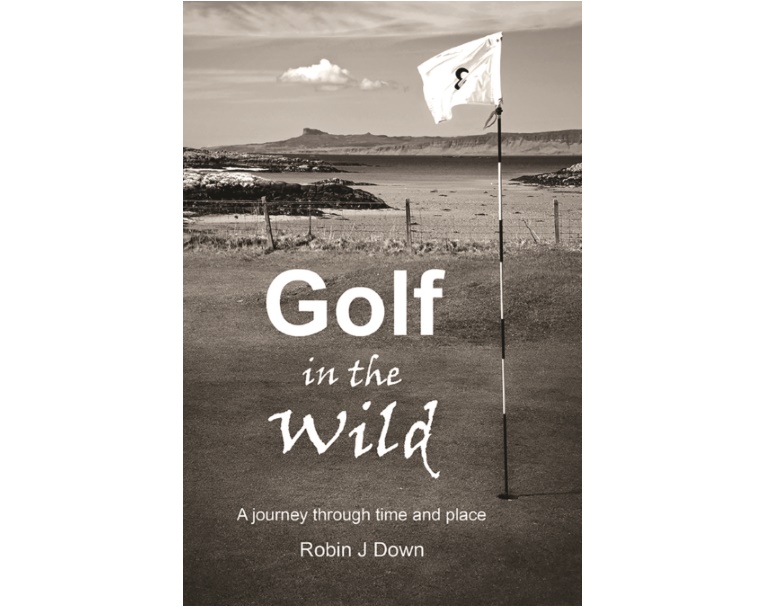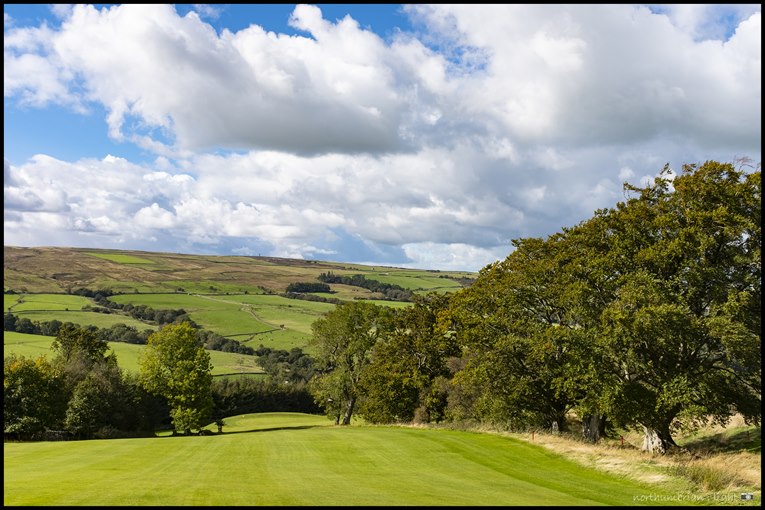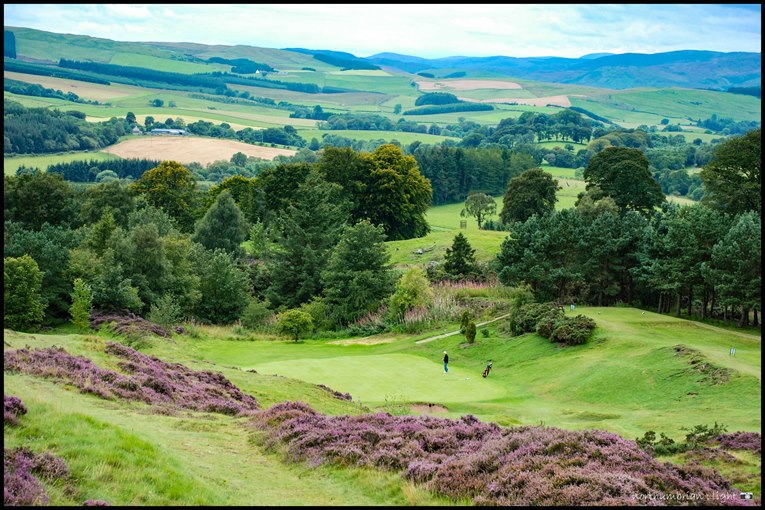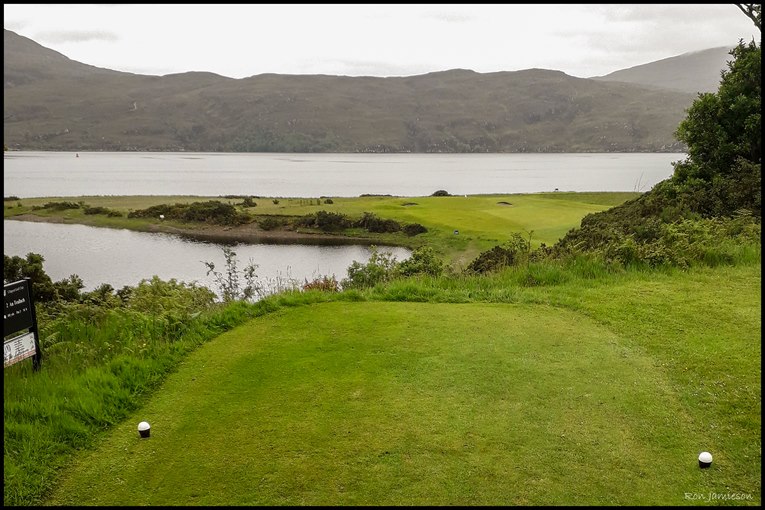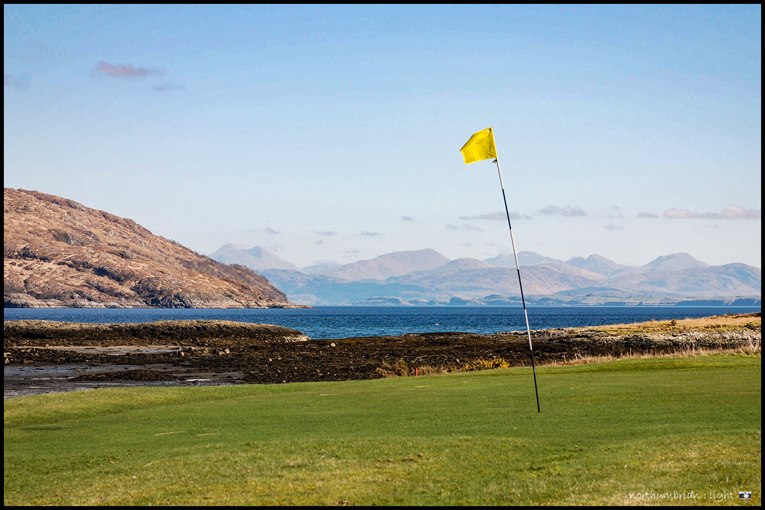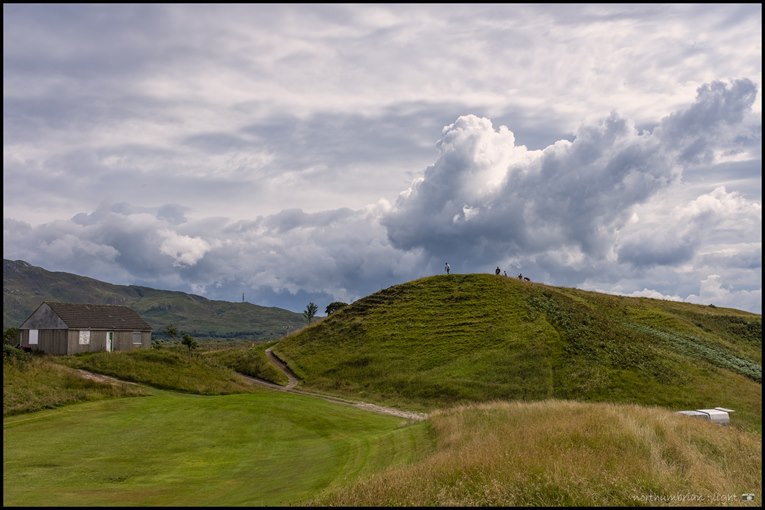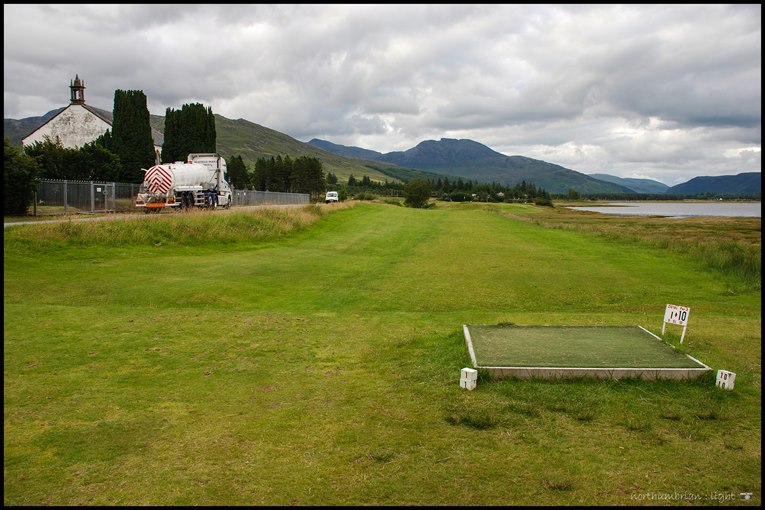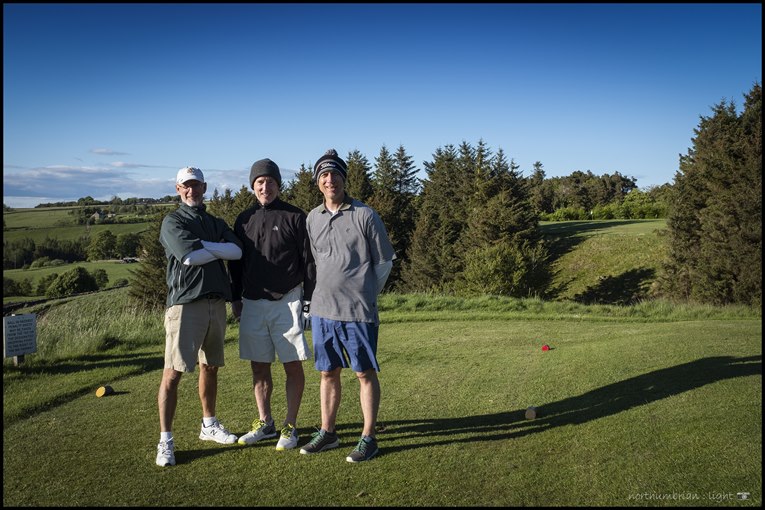Feature Interview with Robin Down
September, 2019
What was your inspiration for writing Golf in the Wild ?
I guess the general motivation was to find courses similar to my home club at Allendale – the magic mix comprises 9-holes, empty fairways, an honesty box and a spectacular location in an out-of-the-way place. The specific moment of inspiration came in 2005 on a visit with family and friends to the shores of Loch Lomond. Left with a day to fill on my own while the ladies went shopping in Glasgow, I headed north to Crianlarich, turned right and found myself in the small town of Killin. On a bright spring day I pitched up at the 9-hole course on the banks of the River Lochay (see the intro to Chapter 4, Killin) and had one of the best day’s golf in my relatively short ‘career’ – I only started playing in 1999. The combination of great weather, beautiful surroundings, some lucky putts and the course empty but for me, made for a perfect and memorable day.
It occurred to me that building a journey based on similar courses could make for an interesting book which at the same time could be used as a basis for promoting Allendale. The title came to me on that day – Golf in the Wild had a nice ring to it and seemed to capture the essence of Killin and Allendale. I had thought to call it “In Search of Wild Golf” but realised I was merely imitating Nicholas Fitton’s “In search of Wild Trout” – Golf in the Wild had a more succinct ring to it. The gestation period was extensive but I started making plans early on. For example, the following year I persuaded the Allendale Golf Club (AGC) committee to name all of the holes thereby providing a hook for building a narrative around the course. The actual writing did not start until I retired in 2011 and the book was published in 2014.
I knew where I wanted to start (Allendale) and I knew where I wanted to get to (Durness). I also knew I wanted to travel via Scotland’s west coast, a part of the UK I knew well and loved long before any thought of writing came to mind. In trying to avoid large conurbations, play only 9-hole courses in fine locations and to construct a journey that would be a joy to drive, the route and the courses more or less picked themselves – the further north you go, the less choices there are, the more obvious your destinations.
The book is written as though I embarked on one long journey of golfing delights. In truth, there were at least six different ‘research trips’ over a period of three years – some to places that were never included in the book because they either didn’t fit with the eventual route or were not quite ‘wild’ enough. Examples are Strathendrick near Drymen (off the route) and Melrose (just off route but also the opening holes are overlooked by a housing estate – a lovely course though and it may well be included in the sequel/return journey).
Why 9-hole courses?
As long-term honorary treasurer (green chairman, webmaster, graphic designer, seniors captain etc) of AGC, I am acutely aware of the particular challenges associated with the survival of 9-hole courses in rural locations with low population densities. Golf in the Wild seeks to demonstrate the joys of these lesser known fairways and attempts to attract new visitors to these sometimes underappreciated tracts. Located just outside a relatively small village, maintaining member numbers is one problem but, persuading visitors to travel long distances to play on a 9-hole course is the primary challenge. The cost of fuel, drink-drive laws and a younger generation with less time on their hands/shorter attention spans means this issue is getting ever-tougher.
Golf in the Wild is ultimately a tool for promoting Allendale as a place to come for a very special golfing experience. With limited resources (financial and human) the critical issue is to maintain the course with a degree of professionalism that will ensure the casual visiting golfer not only enjoys the experience but will want to return again and again.
To some extent we are better placed to survive than some bigger courses – we own the land, we have no debt (other than equipment leases) and we have no immediate competition. Conversely, we have no reserves and survive year-to-year almost entirely on subscriptions and green fees – one bad summer or one major equipment breakdown can be critical. Attracting new visitors takes time and effort. One bad experience and you can lose them in an instant and you will struggle to get them ever to return.
One of the great unknowns about running any club is what attracts people to the course in the first place, be they members or visitors. Endless discussion at the AGM (annual general meeting) will focus on price but there is a distinct danger of trying to undercut competition in a race to the bottom – the truth is green fees are too cheap for the product being purchased. The AGC USP (unique selling point) is location and access – i.e. turn up any time and you can be almost guaranteed an undisturbed round of golf on a near-empty course. Price apart, I am convinced there is a direct correlation between the decline in visitor green fees and the decline in free-to-view golf coverage on the BBC. The move to pay-TV is enriching the few and killing the game for the many.
Do you have an affinity for 9-hole courses? Which are your favorite (even if not included in the book)?
I enjoy 18-hole courses as much as the next golfer and will travel to play many over the course of the year. At heart though, I remain wedded to the special 9-hole clubs in special places. I am no great slam-bang hitter of the ball so distance is always a factor in my ability to score well. And, on the days when the golfing gods are not looking on me favourably, there is much compensation to be had from simply walking through a spectacular landscape with fine views. I started playing the game quite late in life so it was a joy to find Allendale from the outset – a completely unintimidating place where you could build your game without an impatient audience.
First loves never die and Allendale is where it all started. Needless to say it remains my favourite place to play the game but, I confess, when the highland air is bright and clear, the sun high in the sky over The Small Isles, I long to be at Traigh Golf Club near Arisaig. It is the most stunning course in a very special location and, having become a friend of the owner and a country member, I return at least twice every year to take part in their July open and their Seniors’ open in September. It is always a risk though – I have never been wetter on a golf course than on several July visits to Traigh!
Others I would recommend are Killin, Covesea on the Moray coast (in the sequel) and probably Melrose. Finally, for the challenge of getting there and playing golf in the wildest of locations, Durness is an absolute must.
You write, ‘Golf in the Wild is about slow time, the land, silence and escape.’ And to me that perfectly sums up the allure of your book and people interested in those four qualities will find great comfort in reading your book. Please expand your thoughts on this.
Modern society is all about speed, efficiency, getting things done, moving onto the next ‘big thing’. Our minds are never still. Golf in the Wild is the antidote to all of this. Alone in an inspiring landscape, no rushing to another appointment, your mind solely concentrated on hitting a small white ball the best you can with only birdsong breaking the silence (and, ideally, the waves crashing). On the right day, on the right course, heaven exists on earth. Changing the game to ‘speed it up’ I consider to be an unnecessary diversion.
Discuss the autobiographical aspects of the book. It was interesting that you included detailed references to your mother early on in the book.
As I explain in the introduction, golf is simply not the best of subjects to write about – it demands digression in order to maintain the reader’s interest. At the time of writing, my mother’s health, both physical and mental, was in decline. We never had a close relationship and writing about growing up under her ‘authoritarian regime’ became a cathartic exercise. It is one of four themes that run through the book and they come together in the closing chapter – my family relationships (primarily my mother and my maternal grandparents), my experience of motor racing and the heroes from the desperately dangerous years of the 1960s and 1970s, local history and the golf courses along the way – roughly a quarter of the book each. The non-golf sections more or less wrote themselves and interweaved to build what ultimately became a journey into my past.
You note that you ‘seek out places where a middling golfer can enjoy his game, unintimidated by the course, crowded fairways or over-sized saloons with over-sized owners wallowing in over-sized car parks. I want to be relaxed by golf, I want visual stimulus and I want to be elevated by the experience, not depressed.’ Tragically, the things you espouse seem almost revolutionary! Where did things go askew for the 12 to 24 handicap player?
Golf has lost touch with its roots. It did not grow out of 7,000 yard tracts designed to cope with the latest driver technology – it grew out of a Victorian enthusiasm for fresh air and fun in the late 1800s when bands of local enthusiasts established hundreds of small 9-hole courses in the wildest of places. If you want some idea of just how many there once were, I recommend acquiring a copy of Forgotten Greens – The Abandoned Golf Courses of Scotland by Harry Ward (editor’s note: Harry Ward was the May 2019 Feature Interview on GolfClubAtlas and his interview can be read here). The numbers are quite staggering. If UK golfers spent less money on the latest offerings from Ping, Taylor Made et al, and more time investigating the many and varied places you can play, they would have a far better appreciation of this most addictive of games and their golf would probably improve too.
Describe some of the colorful characters that you met along the way in visiting the courses/on the journey.
The colourful characters I met were mostly metaphysical – the ghosts of parents, grandparents, racing drivers, odd characters that wandered the highland landscape, both recently and in the distant past. The highlands are full of stories – it is the true ones that surprise the most. Anyone heading for Durness, golfer or otherwise, should take the time to walk out to Sandwood Bay from Blairmore – “an empty corner of an empty land” where I first came across James McRory-Smith, a hermit who for many years lived out of Strathchailleach Bothy. Sandwood Bay is a ‘thin place’ – a place where “only tissue paper separates the material from the spiritual”. It is a land of ghosts – Vikings, shipwrecked sailors, abandoned crofts.
Tell us about the sequel book.
The sequel is taking longer – the first book was much easier – I knew the landscape well and I knew exactly where I was heading. The sequel has been more a magical mystery tour. Starting at Durness, the finishing point for Golf in the Wild, the sequel is named Golf in the Wild – Going Home and will take the reader across the north coast of Scotland and then along its eastern edges, the Moray coast, the Grampians, towards Edinburgh and then through the Borders back to Northumberland. The final destination will be one of the original course locations at Allendale (Thornley Gate).
In writing terms I have reached the Moray coast and I am about to head south towards Fife – the actual route has yet to be determined – I have had several pleas for inclusion in the sequel which I am trying to accommodate. The research has been very enjoyable – the writing equally so. I get the greatest satisfaction from laying out the text and covers such that it becomes a book I would want to grab from the bookshop shelf. Apart from limited guidance and of course my youngest son’s drawings, I was responsible for every aspect of the book’s production.
Why not just 9-hole courses again for the second book?
It is all down to necessity – there are simply no 9-hole courses in the very far north along the route between Durness, Thurso and Wick (there used to be four – Tongue 1895-1914, Melvich during the 1890s, Dunnet Links 1893-1921, Dunnet Bay 1921-1939). Some of the next book courses may be 18-holers but in every other aspect, Reay and Wick fit the Golf in the Wild bill – empty fairways, spectacular locations and honesty boxes. Perhaps the stand-out odd ball for the sequel will be Fortrose & Rosemarkie – the only golf course on the Black Isle – a lovely 18-holes in a fine location, it would be churlish to exclude given the route I am taking even if it is too busy/professional to be thought of as a true Golf in the Wild destination. On this basis I could be criticised for excluding other fine courses in the far north such as Brora, Golspie and Dornoch but they have been much written about elsewhere and the journey is not about inclusion of every golf course along the way – it is about what is interesting and fits my chosen route.
Talk about the day-to-day running of Allendale. How many people are employed? Other than the honesty box for green fees, does the club have additional sources of revenue?
We have one employee – Neil, the greenkeeper. He is a keen golfer, knows how to present the course and is learning fast. He recently sold the family farm but still maintains a flock of sheep. His heart is in the course and he only charges for hours worked – this flexibility saves the club an enormous amount on wages. If the weather is bad and he cannot cut the fairways, he stays away. In addition we have one volunteer greenkeeper, Ian, who spends endless hours on the course because he loves being there. He also runs the bar!
All the club administration is done by volunteers, mostly myself and Neil (yes, he is volunteer club secretary too). We may be small but we embrace technology (my IT background helps). All taxation has been completed online for years, long before it became mandatory. We were the first club in the UK to run our handicap system on a hosted service (the requirement was delivered by HandicapMaster Ltd at our instigation). We may run an honesty box system but we encourage online booking for tee times and opens. Take a tour around www.allendale-golf.com to get a flavour of it all.
Other revenue sources include Feed-in-Tariffs from the wind turbine (about £2.5K per annum), tee sponsorship (about £2k per annum), the bar (about £1K per annum) and various fund raising activities (about £1K per annum). All fairly modest figures but significant when you consider that the entire show is run on an annual turn-over of just £35K.
How many rounds per day is a ‘busy’ day?
There are no busy times (except when comps are run on Sunday morning and the few Saturdays when there are opens). If you turn up without booking, chances are you will be the only people on the course. A busy period would be when a dozen have been out all day – this is ‘Millionaire’s Golf’ at knock-down prices. The setting is magnificent and the course always well-presented. What more could you ask! (there is a theory that we don’t charge enough – ‘serious’ golfers assume it can’t be any good at just £15 all day).
How often are the prepared surfaces mown?
This is the cutting schedule:
1. Greens: 3 cuts per week (inc. weekend for competitions)
2. Tees: 2 cuts per week
3. Fairways: 2 cuts per week
4. Rough: 1 cut per week
5. Change holes: 1 per week (Friday/Saturday)
6. Move tee markers: 2 per week (Mon & Fri)
7. Green surrounds: 1 cut per week
How long are the nine holes at Allendale? How much land do they occupy?
The front 9 is 2494 yards and the back is 2217 – total 4711 yards, par 67. Relatively short by modern-day standards but you need to carefully negotiate your way around the course. Trees, rough, steep banks, gullies and ditches more than adequately protect the course, to the extent that we only have one bunker and that is only maintained for junior practice. Three local professionals played the course in a challenge match for our 2006 centenary : “This course is a great antidote to every new 7,000-yard course being designed for slam-bang hitters – and with the scenery, it’s a perfect place to come and play golf.” John Harrison – coach to Ken Ferrie.
It should also be noted that for most of the holes on the back 9, the tee positioning is entirely different and presents a completely different challenge. The 8th/17th is a good example – on the front 9, it is a 308 yard dogleg par 4 – on the back 9, our signature hole, a 157 yard par 3 over a deep ravine – The Grand Canyon! The total acreage according to our farmer/greenkeeper is approximately 77 acres.
Allendale is located in an Area of Outstanding Natural Beauty. Could permission be acquired today to build such a course? How did the wind turbine come to be at Allendale?
The course has only been at its current location since 1992 – AONB are sympathetic to the needs of tourism and renewable energy. I am not aware of any issues related to building the clubhouse (before my time) but I was intimately involved with installation of the wind turbine and AONB raised no objections – it is an unobtrusive device.
Describe a favorite one shot, two shot and three shot hole from Golf in the Wild.
‘Favourite’ is maybe not the word I would choose – some notable and difficult holes can get between the ears and ruin your sleep patterns. Coming at the end of the round, the 17th, Grand Canyon at Allendale provides an all too regular opportunity to ruin the best of cards. A 157 yard par 3, the carry over the ‘Canyon’ is only about 130 yards but club choice can vary enormously with wind conditions. Finding the steeply sloping green provides enormous satisfaction, an all too rare occurrence. Avoiding the 3-putt provides even more pleasure.
For a par 4, I would select the 6th at Killin. I have a penchant for elevated tees and this one is a particular odd-ball. You climb a set of set of steps to a platform which is outside the boundary of the course (the same platform is used for the par 3 8th at right angles to the 6th). This man-made construction is the high point of the course and takes you half way back down the hill (height variation on the course is 150 feet). With a decent drive a short iron is all that is needed for the approach but the green is elevated, protected by two bunkers and high ground to the left such that everything kicks right where there is deep rough. There is only one place to go – a high pitch onto the back of the green. A very rewarding hole to get right – get it wrong and you could be there for days. (I am intrigued by the establishment of the platform – who came up with the idea, how did he sell it, how much did it cost – I am very familiar with the workings of golf committees having sat on the AGC one for 17 years and I can’t begin to imagine how this proposal got approved!).
For a par 5, it has to be the second at Traigh. A relatively short par 5, it plays across a high sand plateau with the most magnificent views across to the small isles – Eigg, Muck and Rum. The drive is a 180 yard carry across a deep ravine – rough on the plateau to the left and deep gorse to the right – this hole haunts me. Wherever I drive, one of my regular thoughts is “where would that have ended up on the 2nd at Traigh”. It is another hole that varies enormously with wind conditions. For the faint-hearted, there is an alternative route with a fairway to the left that skirts the plateau but then you must flirt with the coast road. The second shot will bring you parallel with a punchbowl green that is tucked into the gorse. A short pitch into the green and a two-putt will provide a very satisfying par – another hole that is rewarding to get right, expensive to get wrong.

Traigh – #2 Spion Kop punchbowl green. An Sgurr, an inselberg, is on the horizon just above the flagstick on the Isle of Eigg and to the right is the Isle of Rum, both small isles of the Inner Hebrides.
What are a few of the most noteworthy or singular hazards across the dozen plus courses in your book.
The sea at Durness – the shot across the cove is a ‘cinch’ on the front 9 at 109 yards, much less so on the back 9 at 155 yards – I was delighted with a par to complete the last hole of the Golf in the Wild Tour. Ravines seem to feature regularly but for an out-and-out nightmare, the first at Lochcarron beats the lot. It runs parallel to the unprotected A896, just 18 yards to the left. A few yards to the right is the marshy shore of the loch. A par 3 at 210 yards, there is burn running right to left at 126 yards and there are heavy bushes to the left of an elevated green – stand on the tee and it seems there is simply nowhere to go. Finishing the hole with the same ball you started with is a major achievement.
Tell us about the nature of the clubhouses that you discovered at the courses in Golf in the Wild.
They are a world away from the plush surroundings of a well-heeled 18-hole course and on a different planet from anything to be found at, or near, St Andrews. There are many styles of clubhouse to be found on the Golf in the Wild journey but Strathtay typifies the atmosphere at many small clubs across Scotland, from the Borders to the far north. The clubhouse is approached across the first and ninth fairways (there is no paved access), it gives the impression of a building that dates from the birth of the course. In reality it may have been through several upgrades but the atmosphere is tied to a distant past. Pine-panel lined and slightly musty, the walls are adorned with photographs of former glories, competition details, handicap lists and rather too many instructions from the committee. All important stuff but dutifully ignored by the members who always have weightier matters to consider – ‘have I packed a banana, will I finally par the fourth’.
From recollection, the Strathtay building is unique in that it combines an equipment shed with the main clubhouse. An elevated veranda to the front is optimistically populated with seating for those rare occasions when the sun shines and the midges don’t drive everyone indoors. To the right is protective fencing, designed to catch stray balls flying in from the 9th tee. The building has character, provides a tangible connection with the birth of the club and if the walls could talk, there would be many a ‘gawdy night’ to relate.
Do these rural gems face the never-ending battle of attracting visitors? If so, how do they do that? How many golfers from American soil have visited Allendale in 2019?
It is a constant source of concern – the local population is simply not big enough to entirely support the course. Our USP is location and empty fairways and this is what we focus on in our advertising. I think it is probably true to say that we have had only three American visitors this year – the famous Dutton brothers!
What are the general size of the memberships at the courses from Golf in the Wild? Would it be accurate to state that all the courses in your book are a part of their community and that they reflect on the charms of those areas?
This will not be true for all but I would guess the majority are around the 100+ mark and the majority are very much community courses. Allendale is registered as Community Amateur Sports Club (CASC) with the tax authorities (HMRC – HM Revenue and Customs) and this attracts a number of taxation benefits. As with Allendale and many other courses – you get the best impression of the villages and its environs with the views from the golf course.
To purchase a copy of Robin Down’s book, Golf in the Wild: A Journey Through Time and Place, please visit https://golfinthewild.org.uk/purchase
or email robin@robindown.co.uk


